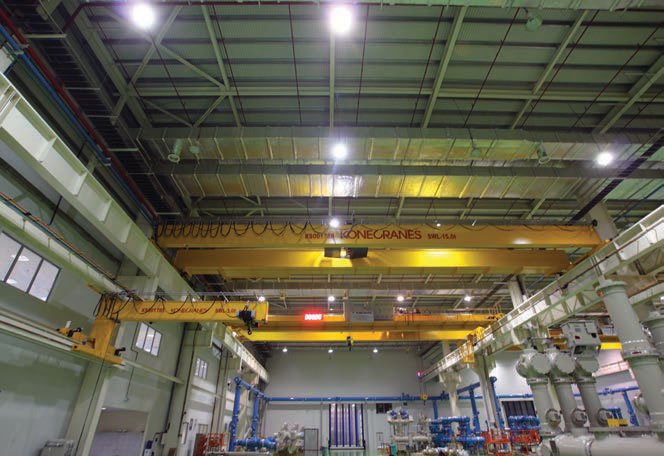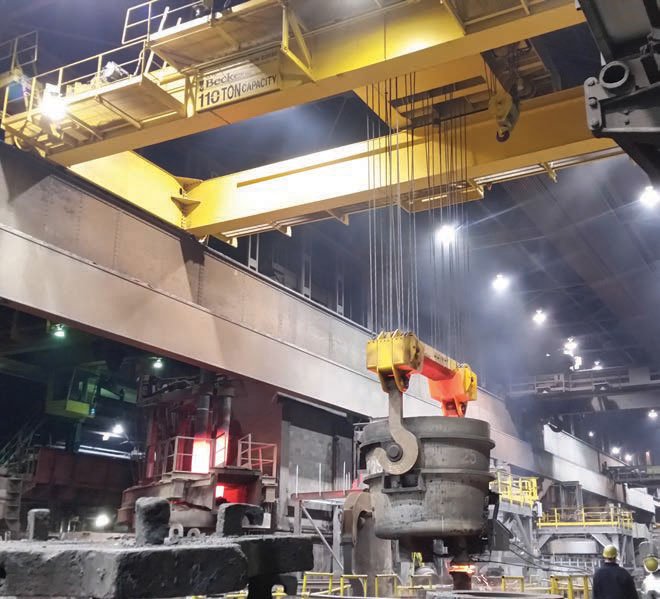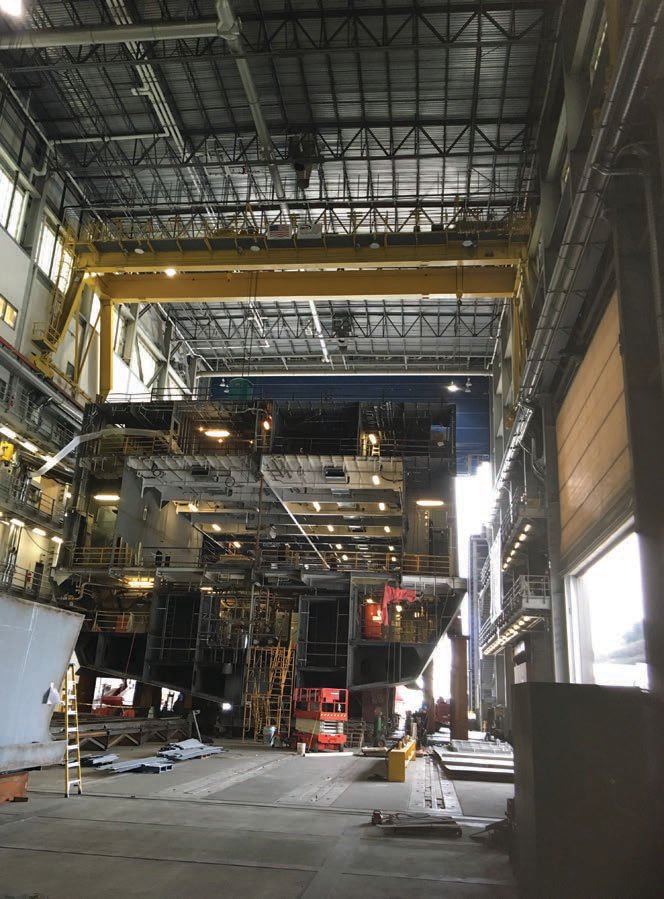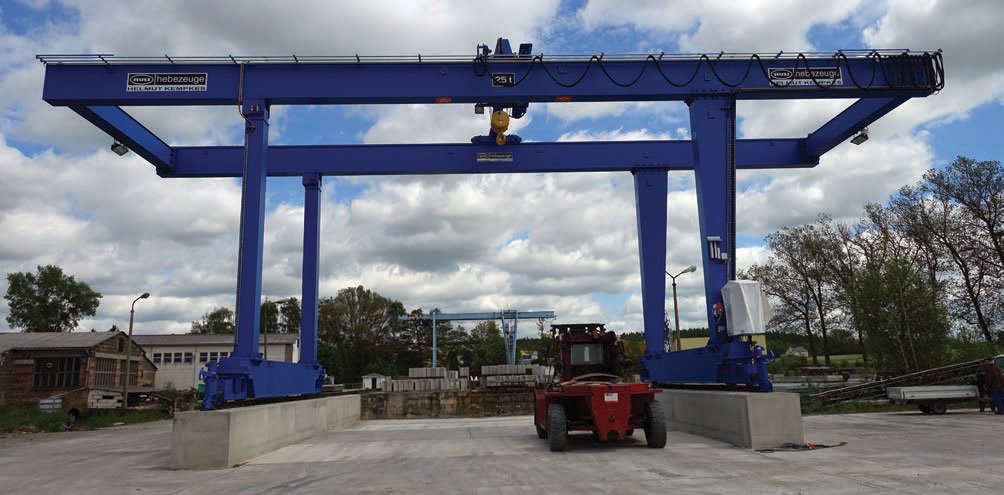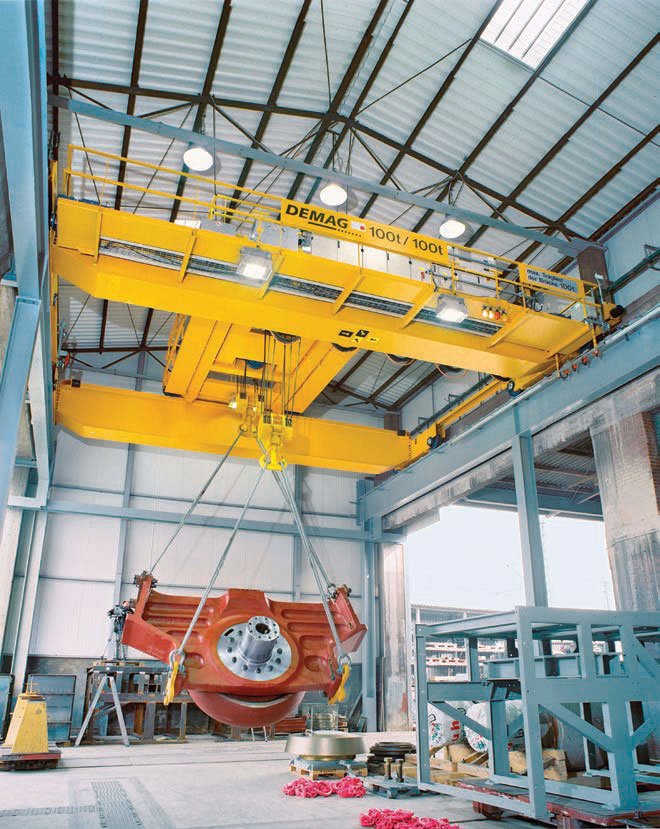Big Issue
14 August 2017A robust safety culture is driving the market in the heavy lifting sector of the crane industry. Paola De Pascali reports.
The demand for much higher capacities, often over 10t, drives the demand for more safety and precision in the heavy manufacturing industry.
Street Crane sales director Chris Lindley- Smith says that at least 70% of the cranes the company manufactures are between 5 and 10t safe working loads and the majority of the rest are over 10t safe working load in capacity.
“Our customers are demanding cranes that offer them the highest levels of efficiency, durability and reliability,” Lindley-Smith says. “They want the assurance that their heavy lift and heavyduty equipment will be robust enough to operate in demanding conditions but will require minimal maintenance to maximise availability.
“Safety requirements are a priority for anyone operating an overhead crane but especially for those lifting heavier loads as there are serious legal implications for anyone that doesn’t adhere to safety advice.
“Crane radio remote controls are now very popular as they enhance safety by allowing the crane operator to select the ideal safe position that gives the best view for lifting, moving and load placement. Modern crane radio control technology has made this equipment very economical and reliable. “There is also a growing market interest in ‘smart technology’ features, which are electrical and electronic control additions that can make any crane more ‘foolproof’ by including controls that prevent the dangerous use of cranes. “An example of this would be the prevention of side pulling which is one of the most common examples of dangerous crane misuse. In this situation, should an operator attempt to lift a load when the crane hoist is not vertically above the load, then the crane control system will not allow the load to be lifted. Side pulling has in the past caused fatal operator injury so people are becoming increasingly interested in its prevention.
“The use of semi-automated control function is also on the increase. Although automatic storage and retrieval has existed for some time, customers are starting to ask for semi-automatic applications on more standard cranes. This technology enables the crane to automatically travel to the desired location before the operator lowers it under manual control.”
Lindley-Smith adds they are working on some significant projects at the moment: “We are supplying heavy duty cranes to a broad range of sectors ranging from nuclear related projects through to manufacturing and research and development.
“We have also had a major hoist order for a large project with the Engineering Projects Division of the Chinese government.”
Konecranes has launched a safety campaign and implemented new technologies and features into their overhead cranes to provide safer material handling solutions.
Konecranes vice president of crane sales Juergen Gieske says: “Konecranes offers new load control Smart Features also referred to as ‘Safe Features’ such as the Hook Centering, Active Sway Control and the Snag Prevention.
“The Active Sway Control is designed to automatically limit load sway by controlling the bridge and trolley acceleration and deceleration rates. This safety feature helps give you precise load positioning and reduces load cycle times. Perhaps one of the most essential advancements in safe load handling is Hook Centering—offcenter pick prevention technology—that aligns the trolley/hoist over the lifted load so the hoisting ropes are vertical before any trolley or bridge movements take place with the lifted load effectively eliminating any off-centre lifted load swing. Hook Centering alleviates any off-centre load swings which is essential when lifting heavy loads like coils of metal or dies used to manufacture car parts to protect an operator or equipment from being struck by accidental load swing.
“The Snag Prevention feature can automatically stop crane movement in such a situation when a hook, sling or load accidentally catches on something while the trolley or bridge is in motion. This feature operates on continuous measurement of the rope angle much like the Hook Centering technology.”
Gieske adds: “Crane speeds are not as critical for some applications as the safe handling of the load. To enhance productivity safely, Konecranes provides the Target Positioning feature, which allows up to 120 pre-set target positions and eight home positions. The operator selects the load’s target address and presses the Target Positioning button. As long as the button is pressed, the crane drives itself toward the selected target position. The hoist can automatically raise the load to a defined travel height. When the load reaches the target position, the hoist automatically lowers the load to a predefined height.
“We also have safety features such as protected areas, to prevent the bridge crane from entering into specific areas of factories where the crane is prohibited to transfer a load. These facilities prohibit overhead cranes from travelling over offices, valuable machines or over a particular working area. This protection is programmed via the smart tablet, which are associated with our radio and cab overhead cranes.”
Talking about the market for heavy lifting, Gieske says they have seen an increase of activities, roughly 20%, in automotive and steel industries over the same period last year.
“We have experienced strong business in the automotive industry, in particular in the stamping plant areas as the automotive companies are tooling up operations for many new models,” says Gieske. “We have supplied bridge cranes to many automotive customers over the past five years in the Americas region. Approximately 30 overhead die handling cranes with a lifting capacity between 45t and 65t have been installed.”
Whiting senior vice president Perry Pabich says they are seeing a lot of activity in many sectors such as metal producing markets automotive and as well as hydropower market.
“In the industrial market we are experiencing a lot of opportunities for modernizations and upgrades to overhead cranes,” Pabich says. “We are seeing additional safety requirements and technology available for supporting and maintaining the overhead crane itself as well as the technology around cranes and performance that enhance the operator and our plane safety around critical equipment, such as no fire zones. That would permit the operator to operate the crane in certain zones to prevent potential collision with plant modern equipment and even things like remote controls and cameras are relevant to check some critical lift areas.”
Pabich says that customers are looking for high capacity cranes, which can be operated in higher speed, but they require also a lot of precision.
“So we are seeing a lot of evolution in crane diagnostics for predictive maintenance as well as overall crane performance and overall machines than the traditional tri-motion overhead crane,” Pabich adds.
Pelloby marketing manager Jonathan Ferris says Pelloby has been operating in the heavy manufacturing sector for several decades and providing robust cranes that are designed to both lift substantial loads and cope with frequent use is often critical. “What this usually results in is a greater need for regular servicing,” Ferris says. “Simple pre-usage checks should really be carried out on a daily basis ahead of each lift performed by the crane, but many of our clients operating within heavy manufacturing environments will have a preventive maintenance contract in place from day one as soon as the crane is installed which will specify regular scheduled inspections and LOLER recommended thorough examinations carried out by a competent person. Getting this maintenance schedule in place at an early stage is often key to maximising the performance of heavy manufacturing cranes and lifting equipment.
“Naturally cranes with large lifting capacities tend to be bigger in size themselves and so maintenance walkways stretching along the span of the crane’s beam—or both beams in the case of double girder overhead cranes—are a common feature of systems for heavy manufacturing workplaces to facilitate access for the necessary servicing work to take place.”
In June 2017, Pelloby dispatched a 10t crane for a heavy manufacturing steelworks in Scotland that featured dual access walkways along its double girder beams, which supported a custom crab unit with two open barrel hoist drums. “Access ladders and safety guardrails are also important on heavy manufacturing cranes for the same reasons,” Ferris adds. “All of these safety features were present in a bespoke 55t semi-portal crane we produced with Mechatherm International Ltd for high purity metal product manufacturers Bridgnorth Aluminium.
“The client required a totally bespoke lifting solution in order to handle heavy furnace lids at their production plant. The finished semi-portal crane had a 12.5m span, an overall height of lift of 6.2m and could lift loads of up to an impressive 55t maximum capacity.”
Pelloby also designed and built a special wire rope open barrel hoist unit and a custom lifting frame in order to safely lift the furnace lids. This frame was a fabricated structure that housed eight large sheaves and was permanently reeved to the hoist unit. The lifting frame configuration was specially developed for safe connection to the furnace lid via the four lifting points.
“Ensuring the furnace lid was moved into precisely the correct position for each lift was a vital part of the crane’s design brief,” Ferris says. “The finished semi-portal crane featured a long travel linear encoder system to give accurate positioning along its travel path. Laser scanners were fitted to the base of the fabricated box construction portal leg sections which halt the movement of the crane if an object or person enters a pre-set programmable area as an extra safety feature in addition to the noise emitter and amber flashing lamp which trigger when the long travel contactor is activated.
“The ladder is located on one of the portal legs to allow access to a high level platform at the top of the crane for maintenance work to be carried out on the crane hoist mechanism, long travel wheels, geared motors, encoders and limit switches. The working environment in which the crane operated was relatively hot, dry and dusty due to the heavy-duty nature of the work being carried out on site. Therefore a special heat shield was fitted to protect the panel, the crane beams and hoist mechanism.”
In terms of the marketplace for the heavy industry cranes, Ferris says: “It’s been pretty steady for us recently—no dramatic increases or decreases in demand but large cranes for heavy manufacturing workplaces are regularly being made in our works.” Engineered Material Handling (EMH) vice president David Comiono says typical markets for heavy manufacturing include shipyards, the aircraft industry and the mining world.
“We have a significant project with the mining industry in Peru,” Comiono explains. “It’s not all with completely new cranes but we are upgrading a lot of older cranes. We are supplying new hoists on bridges with new controls and drives to update these cranes, which are 50t and 60t and have high lift hook requirements.”
Comiono adds that heavy manufacturing sector relies on diverse applications such as technology manufacturers, the appliance industry, and automotive related activities, which have been steady in the past.
“We are not still seeing good results from the housing market, which is something we would like as it drives business for a lot of smaller customers,” Comiono says. “In general the market slowed for the first part of the year, but it’s going much better now. I don’t know if it is real growth, but I can say that it’s much more active.”
Comiono also explains that customers have been demanding fast delivery in addition to safety related issues.
“Most customers usually postpone their purchases, but when they buy, they want the product right away,” he says. “Customers also require safetyrelated features, such as radio remote controls, travel limit switches, monitoring,
technology and overload devices. We work to take care of the very specific technology to satisfy every application and afterward, we try to standardise the solutions.”
Regarding new technologies required in the heavy manufacturing sector, Comiono says customers expect to know what load is on the crane and how much weight they are picking up.
“Another relevant option that we aim to provide in the future is the ability to communicate via WiFi,” Comiono adds. “When it comes to heavy industry, the move is towards wireless communication.”
KULI Hebezeuge–Helmut Kempkes managing director Oliver Kempkes outlines the types of projects that the company has been involved in recently include heavy duty applications, large plant constructions with customised hoist features such as extreme lifting heights, and production and gantry cranes in the Middle East including a large number of crane kits for up to 20t applications.
“We shipped three 120t DGEOT cranes,” Kempkes says. “These cranes have been designed upon special requirements: maximising serviceability and usable workspace, minimised hook approach.”
Another job is in the eastern part of Germany at a precast factory. “Over the last month we supplied a 25t gantry crane to carry out very smooth movements during the handling operations,” Kempkes says. “Every shock movements could have destroyed some parts of precast, but it didn’t happen thanks to the efficiency of our gantry cranes.”
Last February the company delivered a double girder bridge crane to a customer next to Cologne. This crane weighs 53t and can carry loads up to 16t and has a span of 40m.
“A real specialty is the manufacture, supply and assembly of bridge and gantry cranes with rotating crabs,” Kempkes says. “These are manufactured as double girder cranes with spans of up to approximately 70m.”
The bridge crane with a total capacity of 16t is used for the handling of structural steel mats and reinforcing cages with a length of up to 25m. It runs on a newly constructed outdoor railway with a total length of 73m and a span of 40m.
Kempkes explains, “All the components are manufactured in our two production facilities in Remscheid, including the steel construction, control engineering, electrical installation, the manufacture of electric wire rope hoists and wheel bogies. Components such as the motors, gearboxes and rope drums are parts from our modular system.
“The special feature of this crane is that two rotating crabs with two 4t hoists each are used. These hoists can be controlled individually, together and for one or both crabs. With the choice of grippers or the individual operation with hooks, the most diverse transport tasks can be realised, and the materials can be optimally positioned with a total rotation angle of 240°. The crane was equipped with frequency inverters in long and cross travel as well as in the turntables to allow a calm and fast transport of the suspended load. The travel speeds were set at a specific speed of up to 32m/min during the cross travel and up to 63m/min during the long travel. Thanks to a radio remote control in belly type with three master switches and 12 additional selection options, all movements can be performed with highest accuracy.
“The crane has a maintenance walkway along one of the 40m long girders as well as fully accessible turntables. The control cabinets with air-conditioning have been service-friendly installed on the walkway and on the rotating crabs. The two girders each with a length of 40m and the two rotating crabs with an over-width of 4.5m reached a total transport length of 110m.” Other recent applications include automotive, chemical industry, steel manufacturers, building material suppliers, provider of turnkey solutions and public metropolitan railway systems.
“Our cranes are also used underground for the construction of subway and railway systems,” Kempkes says. “For example, two 10t gantry cranes worked overground for a subway project in Cologne and these cranes also supplied material to the underground site where our underslung cranes worked.”
Another project for heavy lifts is the monorail hoist used for a plant project close to Dubai, which still is world record for its kind. The lifting capacity is 192t, with the hoist running on a curved beam.
Regarding the market for heavy manufacturing, Kempkes says it’s running steadily on a good level over the last months. “Our advantage is that we offer a wide range of products, covered by our deep in-house-production like own motors and gear boxes, and that’s something special about our mid-size company. “However, we noticed that the market is moving towards higher capacities because the majority of the companies all over the world want to increase efficiency and productivity.
“Safety is required everywhere and that’s why we are equipping more and more of our lifting products with remote controls and anti-collision systems as well as inverters. For some applications as mentioned above, the, industry is investing in safety features to save money and prevent any kind of accidents. Besides our standard range we also supply customised solutions for special requirements.”
Demag process crane vice president Markus Otto explains customers are looking for tailor-made solutions that integrate perfectly into their processes. “Especially for the flow of materials within the manufacturing processes and in the automated warehouse, customers are increasingly expecting solutions that provide a better coverage of the overall processes,” Otto says. “With our experienced teams we offer highavailability software-based solutions for the mentioned applications that are only peripherally connected to the actual crane. Over the last months we have seen a strong demand and a significant order intake from the automotive, aircraft and paper industries.”
Other heavy-duty applications include steel handling and steel production. “We have recently completed a number of major projects in the aviation industry for a Boeing,” Otto says. “We supplied seven suspension cranes with latching devices and transfer sections, a shuttle system with two suspension cranes and latching devices, each a turnkey project with complete service including measurement of more than 10km crane runways and free standing system.
“We have also worked for well-known automotive builders, supplying automated solutions in press plants for tool handling and storage. The increasing variety of vehicle models has in turn led to an increase in the number of press tools required for the production of the different body parts. This requires intelligent solutions for the change and storage of the press tools using highly developed load handling attachments, automated process sequences and digital warehouse management. Here, we have held a market-leading position for years.” G.W. Becker marketing and business development manager Brent Rozar says safety and reliability have always been the lead in what their customer’s demand from their products.
“Automation, collision avoidance and scale systems are a few add on items, which increase equipment operation safety,” Rozar says. “Several successful recent projects have been fast-track construction projects, which have compressed delivery schedules and required to work closely in conjunction with building design engineers to coordinate a seamless project.
“Some modern technologies have been hoist monitoring systems tracking hours, lifts and faults; sway controls; special below-the-hook devices for keeping the operator away from load; and new developments in synthetic sling material for increased durability and strength.”
GW Becker has recently supplied 16 new freestanding runway systems with a total of 4,060 linear feet and 31 new overhead cranes for one facility repurposing project. Another recent project included the design and manufacturing of an outdoor hoist for a dredge manufacturer. This unit included a large, 750hp, 200 ft lift top-running trolley hoist with a removable weather cover for a 50t crane.
“G.W. Becker has had several significant projects for overhead material handling equipment and systems in our target market segments. The leading industries include dredge equipment manufacturing, which required a continuous severe duty outdoor unit for aggregate excavation; oil and gas transmission, which requested overhead crane equipment for several compressor buildings, gas turbine power generation for installation and maintenance of turbines in power plants; and machinery equipment related to the plastic industry, which required new runways and overhead cranes for entire production facility.”
Regarding the market, Rozar says they have noticed an increase in request for proposals and orders in the heavy manufacturing sector. “Several large manufacturing companies are in process or planning expansion projects,” Rozar says. “Several key projects in the primary steel and railroad industries are in our sales process, which we are confident will turn into active projects.”
Tad Dunville, director of corporate development at ACE World Companies, says: “People are starting to spend a bit more money in order to get the right crane, meaning options that might increase throughput such as unloaded over speed or higher capacities. Industries still feeling the hurt will look for options that may increase cost effectiveness such as modifying the original crane with a new hoist and trolley rather than an entirely new crane.”
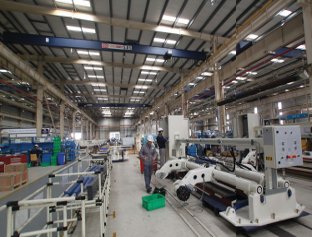 BHS Shanghai’s plant manufactures more than 500 corrugated production units a year. Konecranes technology, including the overhead units pictured, is involved throughout.
BHS Shanghai’s plant manufactures more than 500 corrugated production units a year. Konecranes technology, including the overhead units pictured, is involved throughout.
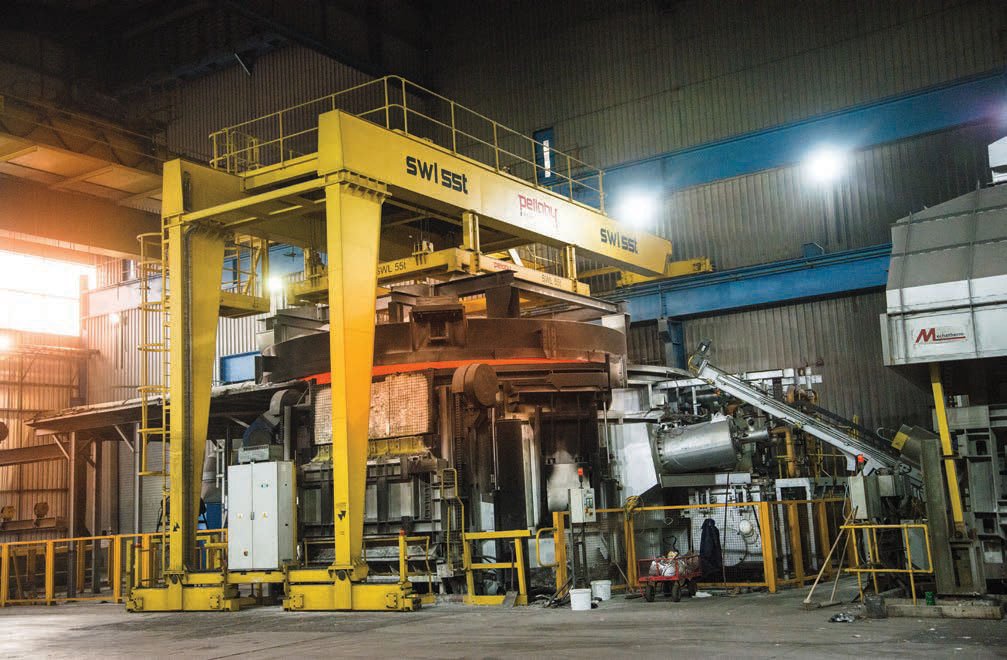 A Pelloby 55t semi-portal crane handling heavy furnace lids at Bridgnorth Aluminium production plant.
A Pelloby 55t semi-portal crane handling heavy furnace lids at Bridgnorth Aluminium production plant.
 An EMH 125t double girder crane with a 10t auxiliary hoist is load tested prior to activation. The crane is used to handle nuclear waste at a disposal facility in Ohio.
An EMH 125t double girder crane with a 10t auxiliary hoist is load tested prior to activation. The crane is used to handle nuclear waste at a disposal facility in Ohio.
